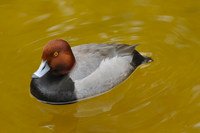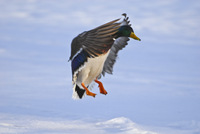Dabbler and Diving Ducks
Post Register June 6, 2013
The mallard and redhead drakes drifted idly on the calm waters of the marsh. The mallard fed along the edge, tipping, head down and curly tail straight up, to feed in the shallow water. The redhead foraged in the deep water. One second he was there, red head and yellow eyes glowing in the sunlight. Then he was gone, leaving behind a swirl of water. He popped to the surface like a cork about 10 seconds later.
Although they are both ducks, the mallard represents a group of ducks commonly called dabbling or puddle ducks—ducks that feed on or near the surface. The redhead is a diver, one of many ducks that plunge under the water and either feed off the deeper bottom or chase their prey beneath the surface.
The difference in how they obtain their groceries has created interesting dichotomies between the two groups. The first, and most obvious, is the placement of the feet. On a dabbling duck, the feet are roughly central on the body. This makes the tip up easy, but diving difficult. It is also efficient for getting around on shore and in flooded fields. The feet on a diving duck are much larger and placed further back on the body. This is ideal for diving and swimming underwater, but makes walking on land a chore.
The difference extends to the wings as well. Dabbler wings are broad and long compared to body weight. When a dabbler takes flight, it is as if it was shot from a catapult--straight into the air and off it goes. Efficient diving requires a smaller more compact wing to body ratio and that comes at a price. When a diving duck takes off, it is more like an overloaded cargo plane. You may catch yourself holding your breath hoping there is enough runway as the duck runs along the surface beating its wings furiously until it gains enough speed for take-off. And the reverse is true at landing. Dabblers are relatively slow fliers and land with pinpoint accuracy. Divers come in fast and again require a runway, skidding across the surface until they stop.
Although you may find both dabblers and divers in the same location, food habits and physical design tend to reduce competition between them. Diving ducks have a penchant for big open water where diving and long take-offs and landings aren’t a hindrance. Dabblers prefer shallow marshes and readily take to land when the occasion calls for it.
Mallards, gadwalls, teal, pintails, and shovelers are dabblers. Most people would count redheads, scaup, canvasbacks, and ring-necked ducks as divers although there are many other ducks, such as mergansers, that dive.
As I watched the mallard and the redhead, I was struck with one fact. Each does what it is designed to do. Although dabblers can dive and divers occasionally feed on the surface, dabblers don’t try to be divers and vice versa. They excel because of it. That’s a lesson I wish I could have learned a bit sooner.


The dabbling mallard and the diving redhead chase groceries in different ways and each is specifically designed for its own strategy.